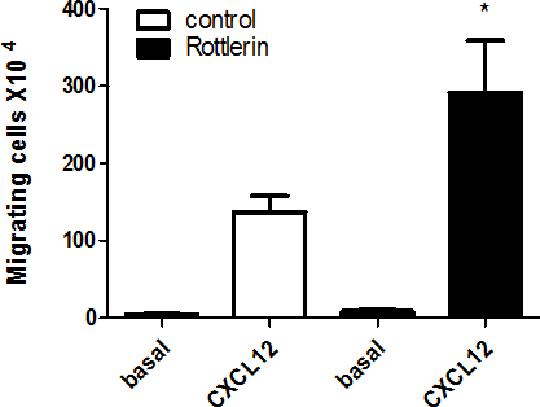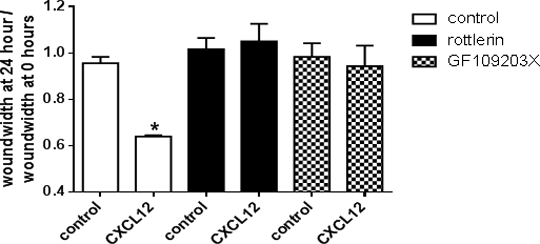CXCL12 Induced Migration Relies On Specific Signalling Cascades In Different Cell Lines
Protein Kinase C (PKC) has been shown to have central roles in signalling in response to many extracellular ligands, and can influence many aspects of cell behaviour. Activation of PKC is one of the earliest events in the cascade of signal transduction pathways leading to variety of cellular response [1]. It has been shown that PKC inhibitors do not affect CCL3 induced cell migration in THP-1 cells [2]. PKC is a family of protein kinases that mediate phosphorylation of hydroxyl groups of serine and threonine amino acid residues on proteins, which are fundamental components in several signal transduction cascades. Kerr et al (2013) have shown that different chemokine receptor signalling networks are regulated in distinct ways [3]. Our aim is to investigate the molecular mechanisms of CXCL12 induced cell migration and the importance of PKC activation in this system by chemotaxis assays in Jurkat cells where cells were loaded in a total volume of 20 μL against 31 μL of 1 nM CXCL12 and number of cells migrating was counted using a haemocytometer after 5 hours, and wound healing assays in MCF-7 cells where images were analysed using a Leica microscope and width of the wound was measured at timepoint 0 and 24 hours after treatment of cells with various PKC inhibitors and 10 nM CXCL12.
Fig 1. Treatment of Jurkat cells with 4 µM Rottlerin does not significantly inhibit 1 nM CXCL12 induced migration (n=6). * denotes p<0.05 compared to control CXCL12. We have shown that PKC activation is vital for cell migration in breast cancer cells, but not in leukemic cells, by using 5 µM GF109203X and 10 nM Staurosporine (non-selective PKC inhibitors), 4 µM Rottlerin (previously known as PKCδ inhibitor) and 11 µM CID755673 (PKD inhibitor). In leukemic cells, only Rottlerin significantly affect migration by increasing the number of cells migrating. In contrast to these results, both Rottlerin and GF109203X showed the opposite effect in wound healing assays on the breast cancer cell line MCF-7, where they prevent effective migration of cells in the wound after 24 hours.
Fig 2. Quantification of migration of cells into the wound. * denotes p<0.05 towards corresponding control. Our study have shown that PKC is essential in different signalling cascades and that the cellular background is important for the distinct signalling pathways used by CXCR4 receptors. [1] Toullec D. et al. The Journal of Biological Chemistry. 1991, 266(24): 15771-15781 [2] Moyano Cardaba, C. et al. Biochem Biophys Res Commun. 2012, 418(1): 17-21 [3] Kerr JS et al. Cell Signal. 2013, 25, Issue 4, 729–735
|





